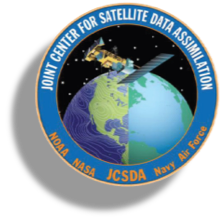The Joint Center for Satellite Data Assimilation
The JCSDA is a multi-agency research center, hosted by the University Corporation for Atmospheric Research (UCAR) and UCAR Community Programs (UCP), committed to improving and accelerating the quantitative use of research and operational satellite data in weather, ocean, climate and environmental analysis and prediction systems. The interagency partnership assimilates many types of data from conventional and satellite sources by creating integrated modeling systems. The JCSDA transitions this research to operational and university communities through a robust data infrastructure and open-source software.
History
At the close of the 20th century, satellite scientists and program managers were dissatisfied with the two-year time period that typically elapsed between the launch of new satellites and the use of operational numerical weather data provided by those satellite sensors for weather prediction. Given the cost of these systems, and their finite lifetimes of five years, it was realized that reducing this time lapse from two years to one year produced a 33% improvement. In 2001, the National Aeronautics and Space Administration (NASA), and the National Oceanic and Atmospheric Administration (NOAA) formed the Joint Center for Satellite Data Assimilation to address the problem with efficient research to operations transitions.
Leaders in Data Assimilation
Effective environmental prediction requires several elements. One of these is accurate, well-distributed observations of the Earth's environment, for which satellite sensors are the largest source. Numerical models that embody the physical and chemical laws governing the behavior of the Earth's land surface, oceans, and atmosphere are another element, as are powerful computing systems to run these models rapidly to provide timely forecasts.
The science of data assimilation is the mortar that binds these elements into successful prediction systems for weather, oceans, climatology, and ecosystems. The Joint Center for Satellite Data Assimilation (JCSDA) is dedicated to developing and improving the ability to exploit satellite data more effectively in the United States. The JCSDA is a distributed, collaborative effort that allows the work required to use the billions of satellite observations available daily to be shared by several operational agencies in the United States.
This activity is best accomplished on a coordinated multi-agency basis, as the common development work necessary to assimilate these many thousands of millions of satellite observations each day would otherwise be duplicated across the agencies.
Observations
Satellite observations acquired
⇣
Data Assimilation
Global Observations Integrated
⇣
Environmental modeling
Run Global Prediction Models
⇣
Environmental Forecasts
Environmental Forecasts produced
“A data assimilation system is only as good as its weakest component.”
What We've Achieved
Built and distributed a Community Radiative Transfer Model (CRTM) to enable partners and collaborators to effectively test and assimilate a variety of satellite data.
Established a common data assimilation structure at NASA and NOAA.
Provided access for all partners to computational facilities.
Prepared to assimilate GPS data from the Constellation Observing System for Meteorology, Ionosphere, and Climate (COSMIC & COSMIC-2).
Demonstrated a positive impact on weather forecasts through the use of advanced operational and research instruments.
Developed a microwave emissivity model for snow and ice that enables the assimilation of 300% more atmospheric sounding data in polar regions.
Transitioned advanced satellite data into operations (e.g., QuikSCAT winds, MODIS winds, Atmospheric Infrared Sounder [AIRIS] data).

